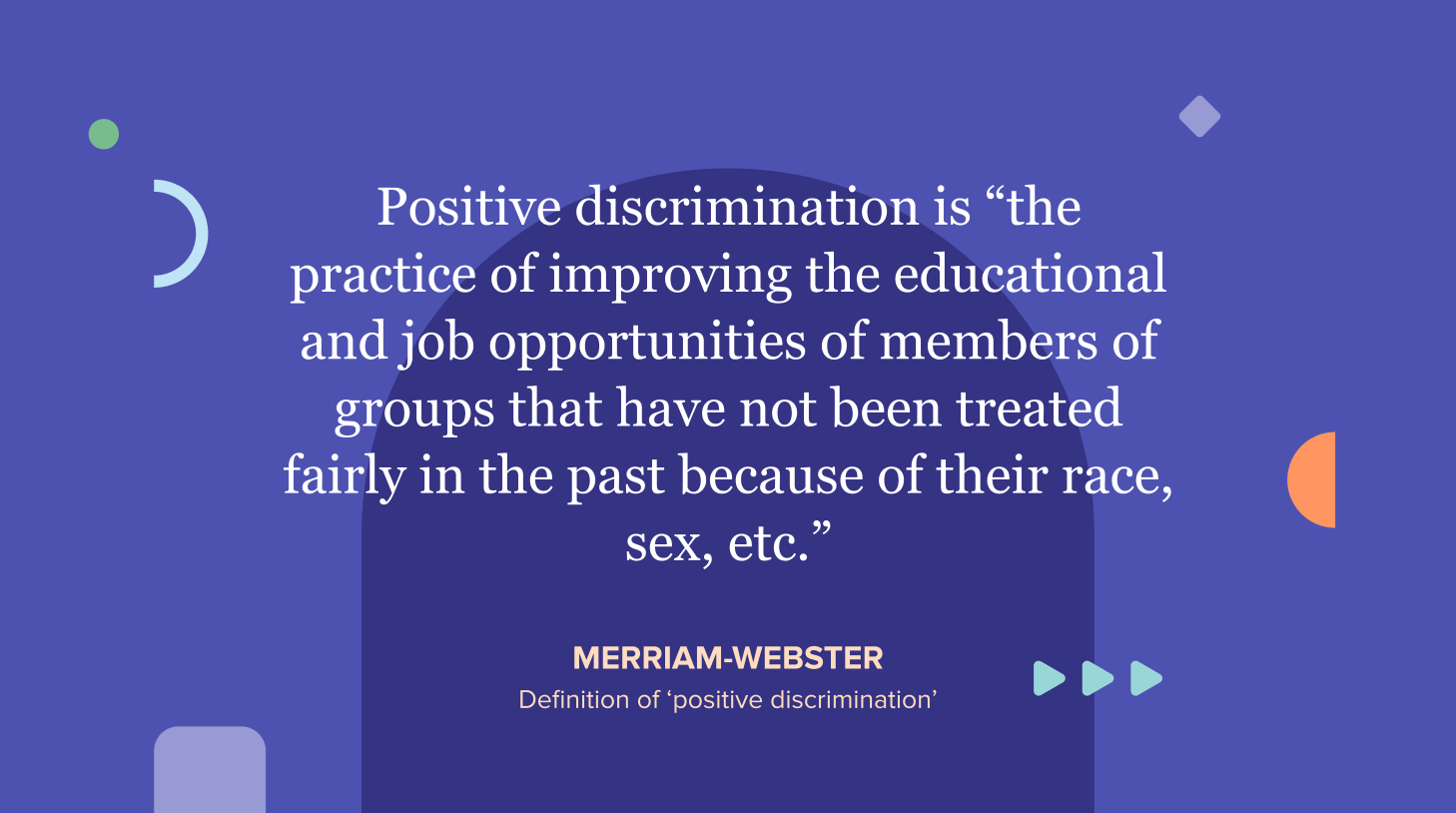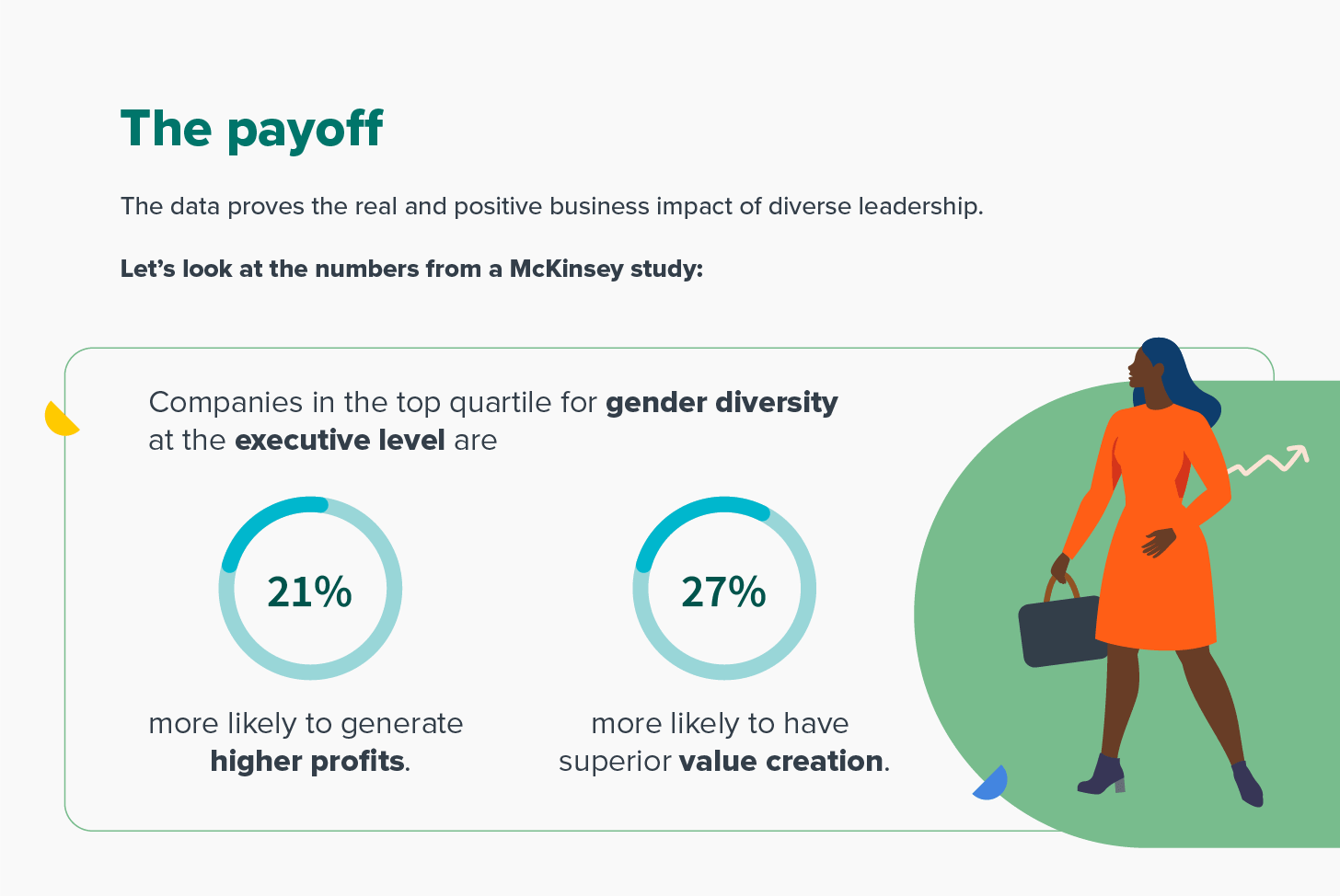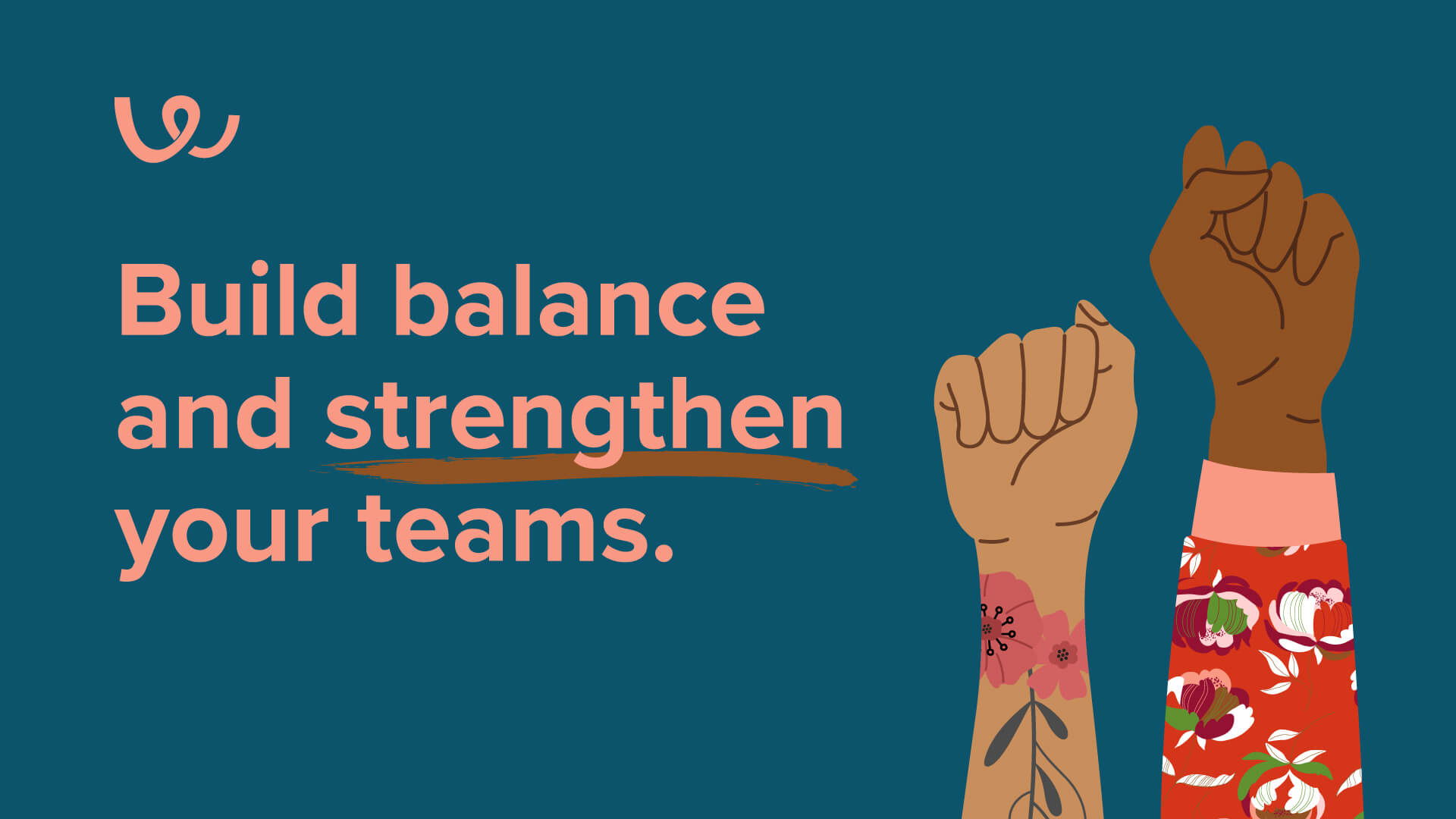Positive discrimination: What it is and how you can implement it
Positive discrimination refers to preferential treatment aimed at bringing underrepresented groups to a level of equity in the workplace. Implementing positive discrimination involves conducting DEI research, implementing a shared vocabulary, selecting leaders who believe in equity, and keeping an ongoing dialogue on the subject.

The first part of this HackerEarth-hosted blog series talks about DEI, an initial framework for your DEI strategy in the workplace, and stresses the importance of diversity hiring not being a one-off effort. Unless there is an ongoing dialogue going where people from different walks of life exchange thoughts, experiences, and ideas, there will not be enough awareness around this topic. In this post, we address positive discrimination.
Those organizations that are taking their diversity and inclusion efforts seriously should understand that one area makes up a crucial part of it – positive discrimination. When done right, it has the potential to holistically improve your company’s diversity hiring practices.
Since diversity in the workplace continues to be held back due to recruitment biases, positive discrimination is even more important to further the cause. Let’s get to it then, shall we? #DEI 101!
Contents
What is positive discrimination?
The first thing that comes to mind when I hear the term “positive discrimination” is the lack of awareness around this subject. What does it mean, where does it stem from, why is it needed, and is it even OK to add this to your company’s DEI policies?
By definition, positive discrimination refers to preferential treatment demonstrated with the intent of bringing an underrepresented group (who possess one or more protected characteristics) to a level of equity in the workplace.
Whether positive or negative, it still is discrimination of some kind. Why should we do it then?
To understand why positive discrimination is required, we need to educate ourselves about equity, equality, and how they differ from each other. Equality means each individual or group of people is given the same resources or opportunities, which takes into account an ideal situation where all people are equal.
Addressing the imbalance of marginalized groups in our workplaces is only possible through equity. Equity recognizes that each person has different circumstances and allocates the necessary resources and opportunities needed to reach an equal outcome.
For a better understanding of these terms, let’s look at two examples:
- A community meeting, where all members of the community are invited, about a local environmental health concern is held in English although 30% of the residents do not speak English.
- At another community meeting, the community leaders hire translators to attend the meeting or offer an additional meeting held in another language.
The first case treats everyone the same (equally), which does not guarantee a positive outcome for all the members. The second instance recognizes the individual needs of the members and takes proactive steps to meet those needs equitably.
My first-hand experience with the above:
Over a period of time, I’ve personally experienced situations at work where I’ve had to learn, and then unlearn to strongly move away from the word ‘equality’ and associate the word ‘equity’ with inclusion and diversity instead. Coming from this place, I believe in positively discriminating for ‘equity’.
More about protected characteristics
Positive discrimination can apply to any person who has at least one of the protected characteristics. The policy was put into place in the 1960s to level the playing field for historically discriminated/overlooked groups. There are nine protected characteristics that fall under this policy:
- Age
- Disability
- Gender reassignment
- Marriage or civil partnership
- Pregnancy and maternity
- Race
- Sex
- Religion or belief
- Sexual orientation
Examples of positive discrimination in the workplace
Positively discriminating for equity can lead to dramatically good outcomes for marginalized communities. The practices a company implements to foster inclusion in the workplace directly help in fostering positive discrimination in the workplace. Examples of positive discrimination that I’ve personally seen are:
- Hiring drive specifically for women candidates to increase the pool of candidates at the source and further gender (women) diversity
- Specific career development program for women, to increase the pipeline and gender ratio of women senior leaders at the top
Such practices help you understand the gaps in your workforce and improve workforce equity so you will be better equipped to make strategic hiring decisions.
What we do at HackerEarth
At HackerEarth, our intent and approach focus on inclusion with the end goal of achieving equity in the workplace. Keeping this at the heart of whatever we do, here are some policies we enforce at work:
- Under our leave policy, we include period leaves for women and paternity leaves for one month
- Employee insurance coverage offers same-sex partner inclusion as part of the policy
We hold awareness sessions specifically to talk about how to use the correct gender pronouns, spread awareness about gender stereotypes and the need to accept non-binary employees into the workforce, and touch upon inclusive behaviors in the workplace, among other topics
My first-hand experience with the above:
Ironically enough, when we first started discussing including period leave in our leave policy, I was hesitant. There were two reasons for this – one was that periods don’t give me acute pain/cramps or discomfort so I can handle it pretty well. The other was we would be showing preference to one gender by giving time off so should we also do something for men, just to keep it even?
I had to think, assess, and justly accept that we have our differences and similarities, despite being of the same gender. While all women have periods, not all react in the same way, which is exactly why we need to provide individual resources based on need. And the same can be said for men. As genders, we are biologically different and will require a separate set of resources to attain the end goal of equality and foster an inclusive workplace.
This was my first brush with the equity vs. equality conflict and needless to say, I’ve been on the side of equitable policies ever since.
Ways to positively discriminate
1. Do your DEI research
Before you blindly start on your DEI journey, you should do your research. Companies must educate themselves on where they currently stand in their diversity hiring, the industry research of past and present companies, and sociological studies. This helps identify gaps in the existing workforce and a better understanding of the strategy you should devise. Go back to the basics of what diversity and inclusion mean for your company and take it from there.
2. Implement a shared vocabulary
Creating a shared lexicon around the correct pronouns to use, and important DEI concepts they should know in your organization – and explaining meanings – is the first way to establish equity. By incorporating shared vocabulary into the workplace, both employees and employers are more likely to identify what is acceptable and what is not.
3. Select leaders who believe in the cause for equity
Identify champions for DEI and positive discrimination at senior leadership and top management levels. They are the ones that can communicate policies and values top-down, ensure that it is a priority, and be role models for the employees to emulate in their behaviors. Also, the higher levels of a company should reflect the diversity of their employees to be a truly inclusive workplace. The data is clear: DEI leadership is crucial for success.
4. Integrate positive discrimination into your strategy
At HackerEarth, inclusion is at the heart of whatever we do. We believe attaining equity in the workplace does not happen overnight. It has to be woven into the threads of the entire organization to successfully build an inclusive culture. Use a combination of leadership training, behavioral coaching, and planning to integrate positive discrimination for equity into your strategy. Give people the correct language to use, ask them to call out behaviors that are not accepted, and sensitize others towards these behaviors. Don’t restrict spreading awareness to only on the marginalized groups – include concepts like ‘allyship’ and positive discrimination.
5. Keep an ongoing dialogue on positive discrimination
Use research and learnings from other companies to start the conversation with your employees who are invested in this cause. Creating an inclusive workplace is creating an organizational culture of belonging that invites and values the contribution and participation of all their people.
At HackerEarth, this is one of the reasons why I decided to keep an open dialogue going to exchange thoughts, opinions, and ideas from different perspectives on my LinkedIn channel.
A word of caution
Practicing positive discrimination to simply fill a company quota is as harmful as taking up diversity hiring just to meet some numbers. It inadvertently perpetuates bias and affects the morale of a company.
Personally, the trick here is to keep equity at front of mind and not lose sight of that. And then use positive discrimination to create better opportunities and visibility for underrepresented groups.
The main word to place the spotlight on here would be “to be given equal opportunity / visibility.” Use the lens of merit, accordingly for all the candidates in consideration. Practice with intent and not just for the sake of it.
Swetha’s bio in her own words: As an HR professional, I’m fiercely passionate about the value I add to the individuals and teams that I associate myself with. Absolutely enjoy working on organizational development, change and transformation management. ‘Cultural transformation’ and ‘Inclusion’ are a few of my favorite topics to talk about. My personal style and approach come from the interest and passion that I share for art and various forms of mind-body expression. I strongly believe in challenging the status quo, whether it is by standing on my head once every day (read yoga), or by standing up and voicing my opinion on diversity and inclusion in our workplaces.
Frequently asked questions
- What is positive discrimination?
- Positive discrimination refers to preferential treatment given with the intent of bringing underrepresented groups to a level of equity in the workplace. It's a crucial part of diversity and inclusion efforts, aimed at addressing recruitment biases and improving diversity hiring practices.
- Why is positive discrimination needed?
- Positive discrimination is needed to address the imbalance of marginalized groups in workplaces. It recognizes that each person has different circumstances and allocates the necessary resources and opportunities needed to reach an equal outcome, fostering a more inclusive and equitable workplace.
- What are protected characteristics in positive discrimination?
- Protected characteristics refer to certain attributes that fall under positive discrimination policy. These include age, disability, gender reassignment, marriage or civil partnership, pregnancy and maternity, race, sex, religion or belief, and sexual orientation.
- How can positive discrimination be implemented in the workplace?
- Positive discrimination can be implemented by conducting DEI research, implementing a shared vocabulary, selecting leaders who believe in equity, integrating positive discrimination into your strategy, and keeping an ongoing dialogue on positive discrimination.
- What are some examples of positive discrimination in the workplace?
- Examples of positive discrimination include hiring drives specifically for women candidates to increase gender diversity, and specific career development programs for women to increase the pipeline and gender ratio of women senior leaders at the top.






